What is Patellar / Quadriceps Tendonitis vs Tear?
Patellar tendonitis and quadriceps tendonitis are terms used when discussing anterior knee pain related to inflammation. These conditions are related to overuse. Athletes, industrial laborers that squat, lunge, run, jump, push or pull can cause repetitive stress to this area creating unwanted inflammation and pain. In addition to the repetitive stresses, muscular imbalances, muscular tightness or weakness can be a contributing factor to these symptoms.
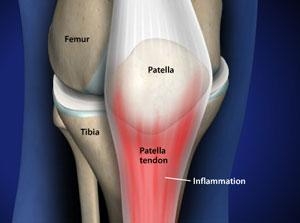
Tendonitis of the Patellar Tendon
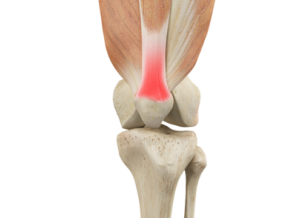
Tendonitis of the Quadriceps Tendon
The knee is the largest and one of the most complex joints in the human body. The joint and its components function together to provide stability and power for activities of daily living and athletic movements. Muscles are connected to the bone by tendons. Muscles and tendons provide the motion of the joint. The quadriceps (thigh muscle) is connected to the patella (knee cap) by the quadriceps tendon. After crossing over the patella, the patellar tendon inserts onto the tibial tubercle (upper portion of your shin). These tendons promote knee extension – straightening of the knee.
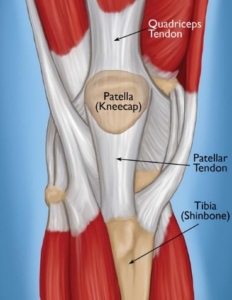
However, these structures can be injured or damaged requiring corrective treatment as easy as rest and therapy to as complex as surgery. Regardless, either treatment will typically allow a full return to work, activity or sport without additional complications. As discussed tendonitis is inflammation of the tendon caused by overuse. If left untreated tendonitis can progress to partial tendon or complete tendon tears. Tendon tears or ruptures are typically traumatic but can be caused by chronic diseases such as diabetes mellitus, metabolic disorders, rheumatoid arthritis and chronic steroid use. Partial tears are when the tendon is not completely interrupted. Meaning that only a certain portion of the tendon has torn. Full or complete tendon tears typically results from a very strong force such as a fall or jump severing the tendon into two or multiple pieces but can result from prolonged diseases.
Signs and Symptoms
Signs and Symptoms of tendonitis in either the patellar or quadriceps tendons most commonly are associated with a dull ache overlying the anterior or front of the knee. Typically begins gradually and as activity continues or if left untreated symptoms worsen. As symptoms worsen, the dull ache becomes sharp. Symptoms can become debilitating especially with repetitive climbing, squatting, jumping and lunging. Additionally, bouts of instability may occur from pain and weakness, stiffness with prolonged sitting and generalized knee swelling. Untreated, chronic inflammation can lead to weakening of the tendon, disruption of blood supply to maintain tendon health leading to rupture. Signs and Symptoms of tendon tears will typically present acutely and traumatically. Caused by a force fall or jump. Severe pain, swelling, redness, discoloration, deformity, extreme weakness to extend the knee straight from a flexed (bent) position and inability to bear weight on the injured extremity.
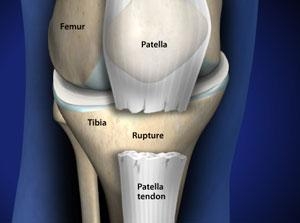
Complete Patellar Tendon Tear
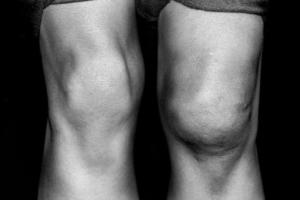
Normal knee vs Tendon Rupture
Diagnosis
Diagnosis will be determined through a thorough history and physical examination by a trained sports medicine and orthopedic knee specialist. Examination will consist of palpating the knee complex for pain and a visual examination for deformities. The clinician will check both active and passive range of motion. Specific manual tests will be performed by the specialist to determine if inflammation exists, the amount of weakness, instability and other possible factors causing symptoms. Once the initial diagnosis has been made, radiological examinations may need to take place for further assessment. X-rays of the knee complex may be ordered to evaluate patellar alignment and also to determine if any other bony conditions exist such as fracture or loose body. If additional concerns from initial exam and assessment are present an MRI (3 dimensional picture) may be ordered to assist in determining the final diagnosis and prognosis.
Treatment
Treatment for tendonitis and partial tears of both quadriceps and patellar tendons may include immobilization, rest, ice, compression, anti-inflammatory or narcotics medications, decrease or change of activity level, weight loss, physical therapy, therapeutic taping and or bracing, (PRP) platelet plasma injections and stem-cell injections. Tendonitis is treated conservatively. Surgical open tendon debridement can occur if conservative management is failed, but occurs in less than 2% of the population. Treatment for complete/full patellar and quadriceps tendon ruptures requires surgical intervention. This is an open procedure in which the surgeon reattaches the tendon to the patella (knee cap) by using very strong sutures that are anchored or tightened to the patella. The success of the operation is dependent on how soon the surgeon gets to repair the damage. Even though it is an open surgical procedure, it typically is performed at an outpatient surgical center.
Rehabilitation
Rehabilitation in either case of non-surgical or surgical care is required. Depending on your diagnosis your sports medicine physician will determine a personalized treatment program that fits your needs.
- Non-surgical management can consist of immobilization, rest, ice, compression, anti-inflammatory or narcotics medications, decrease or change of activity level, weight loss, physical therapy, therapeutic taping and or bracing, (PRP) platelet plasma injections and stem-cell injections.
- Surgical rehabilitation and recovery will require initial immobilization in a splint or cast for 4-6 weeks. As time progresses, weight bearing will be increased, range of motion will be regained and strengthening of the muscle/tendon complex will be managed through formal physical therapy. Rehabilitation period is approximately 4 months.
